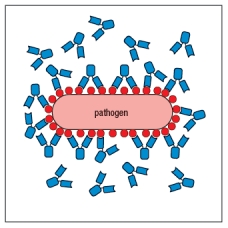The drawing in Figure shows antibodies bound to repetitive epitopes on the surface of a bacterial pathogen. Even though all of these epitopes are identical, not all of them have antibodies bound to them.  Figure The most likely explanation for this failure of antibodies to bind to every possible epitope on the surface of the pathogen is:
Figure The most likely explanation for this failure of antibodies to bind to every possible epitope on the surface of the pathogen is:
A) There is an insufficient amount of antibody to saturate all the epitopes.
B) The pathogen has an immune evasion strategy to avoid antibody binding to all epitopes.
C) Some of the epitopes cannot bind antibody due to steric hindrance.
D) The antibodies are only able to bind when both antigen-binding sites are engaged on the pathogen surface.
E) The epitopes on the pathogen are not all in the same conformation, so not all will bind the same antibody.
Correct Answer:
Verified
Q5: MHC genes are the most polymorphic genes
Q6: In Figure Q8), which close-up view of
Q7: When a mixture of different IgG antibody
Q8: Early studies analyzing the antibody protein fragments
Q9: Which of the two antibodies shown in
Q11: Individuals or mice with defects in the
Q12: Amino acid sequence analysis of all of
Q13: Antibody binding to a pathogen surface is
Q14: Like innate sensors of infections (TLRs, NLRs,
Q15: Once expressed on the surface of host
Unlock this Answer For Free Now!
View this answer and more for free by performing one of the following actions

Scan the QR code to install the App and get 2 free unlocks

Unlock quizzes for free by uploading documents